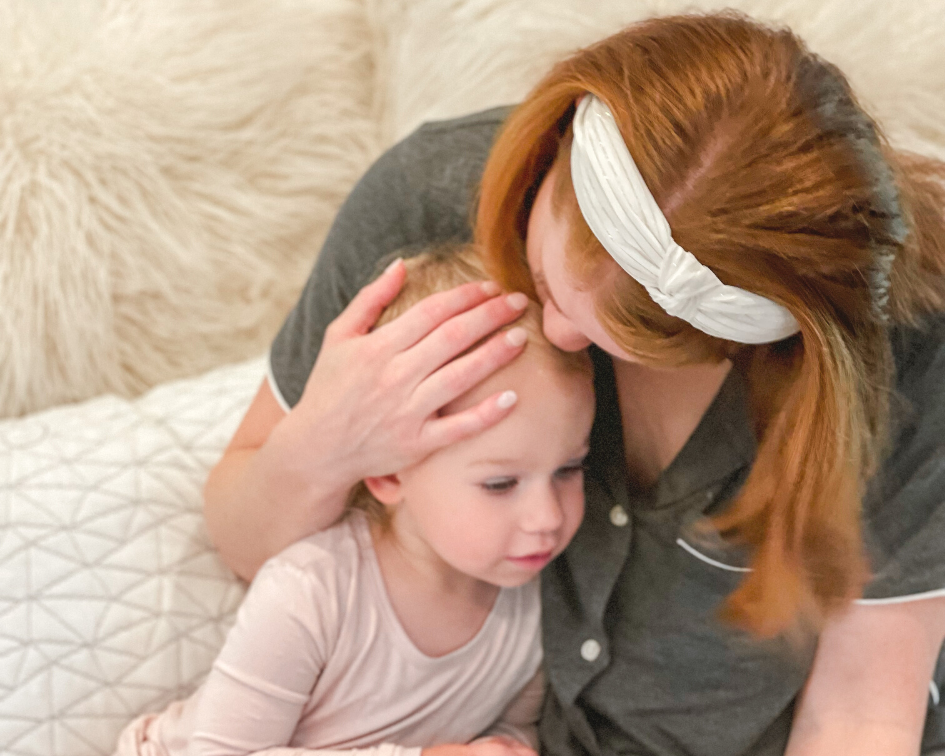Around your little ones' 2nd birthday, you may start to truly see them becoming a toddler in their behaviors. Some of these behaviors are exciting and I personally loved seeing my daughter start to become her own self. However, the impact that toddler development can have on their sleep can be less than pleasant for us as parents. Let's talk about how we can use a little parenting toolkit to help get your routines back on track and feel confident about being a #toddlermom or #toddlerdad.
Why is this happening?
When your little one approaches 2 years old, they are entering the preoperational stage of cognitive development. This is the 2nd stage of development and it actually lasts from 2 years old to 6 years old. (Hint: these tips are going to help you with your child for the next 4 years!) As they enter this developmental milestone, language starts to develop and explode in the next year. This is mostly a blessing because we can now communicate both ways as we reestablish sleep routines and boundaries. In addition to language, your toddler's view of the world is very egocentric (meaning it's all about them). It's not that they mean to throw tantrums when life does not go their way, or that they do not want to share, it is how their brain currently operates. (Another hint: the toolkit I am about to give you helps develop the brain to be empathetic and more logical!) With all this going on, they are also wanting to be independent and try new things (AKA test boundaries), but they know they still need and want your help.
The Toddler Parenting Toolkit:
Before we dive into sleep-specific things, we need to cover the 5 tools that you need in your toddler parenting toolkit. These scripts and methods can help you manage through the things that come with parenting a toddler in a way that helps them develop their brain and leaves you both feeling positive about yourselves. These tools will strengthen your parent-child bond and meet your child where they are in their development. We want to see everything as an opportunity to teach our children rather than punish them -- that way when they are left to make decisions on their own, they know what to do! Obviously, this takes time, which is why using these tools as our children's brains develop is key.
1. Arouse Empathy: We want children to realize their behaviors impact others. Remember, they are egocentric right now, but the more we show them how they impact others, the more they will develop and understand their impact on the world around them. A simple example is, "Wow, look at how rested my face is today, you slept all night in your room and we all got great sleep!" A nonsleep example would be, "you really helped me today when you picked up your trucks!"
2. Tell your child what they can do: This is a huge one! Tally how many times you say no to your child right now -- we all do it and it is a lot. Every time we say no or don't, our children often hear "do." Instead of always saying no to them, we can rephrase these statements into a "yes." Here is an example: "It's time to eat dinner, we can have a snack later, what one do you want to save?" A sleep example could be: "It is time to rest our bodies now, let's do that now so tomorrow we can play trucks together." Here are a couple more examples because this tool is so powerful: "sand is not for throwing, you can play with the truck in the sand." "Markers are for coloring on paper, not the walls. Since we drew on the wall today, we are going to put the markers away and tomorrow you can try coloring on paper." Notice how in all of those examples, we are telling our child what they can do when we tell them what they cannot do. One last tip for this tool is to pick your non-negotiables & safety rules. These are the rules where you do use "no." It helps "not" to not become overused and keeps it powerful for important times.
3. Validate & Connect: This is my favorite tool. When we validate and connect with our child (or anyone for that matter) we take away so much of the angst in a heated situation. All we have to do is start by validating how your child feels in the moment, we do NOT have to solve the tantrum or problem. It is simply not going to happen each time. Take a deep breath, get down on their level, talk calmly and quietly, and then validate. Here is an everyday example: "I know you want ice cream right now, it is SO delicious. I love ice cream too. We can have some tomorrow." Here is a sleep example: "I know you want to cuddle more and for me to stay in your bed. I love the cuddles we just had, we will get to have more tomorrow night!"
4. Layer on the love: The more we can celebrate our children and make them feel good, the more cooperation will naturally occur. When they do not feel like you are telling them "no," "don't do that," and "stop that" over and over, the more they will feel the love that we want them to feel. I know there are tough days of parenting, believe me, there are days where I wish I could have a do-over. When you have a bad day, use it as a chance to reset, revisit your toolkit and make an effort tomorrow. Tell your child what you love about THEM, what they did to make you feel good, and what they cooperated with. "You held my hand across the street, that was so safe!" "You stayed in your own bed all night, we all feel so rested!" "You used your calm voice to ask for help, thank you." Showering them with these phrases will make everything smoother, including your bedtime routines. Combine this positivity with one on one undivided attention time. If they are "acting out" or extra hyper and not listening, it is likely because they are seeking connection.
So how can I get my toddler's sleep back on track?
1. Reestablish the routines: First things first, your child thrives off a routine and predictability of what is coming next EVEN if they are pushing those boundaries. We need to re-establish the bedtime and naptime routines. This included making sure the timing is right. The number one thing I see with 2-6 year olds is a bedtime that is too late because the bedtime routine gets so hectic, and by the time they are asleep, it is 9-10 PM. We really want our toddlers and preschoolers in bed between 7-8 PM. If they are not napping, bedtime should be 6:30-7 PM. If they are napping, it should be 7:30-8 PM. This is referring to lights-out time. It's ok for them to take 15-30 min to calmly or happily fall asleep, we just do not want them getting out of bed and crying, In addition to timing, we need to double down on the actual routine. It can be helpful to involve your child in decorating a poster or book about their bedtime routine and then talking through it together. It is your job as the parents to guide the routine and keep it on track. Use the parenting tools to do this. Give them a heads-up on what is coming too. An example is "When the water runs out of the bath, it is time to get out." "Let's pick out the two books to read." "Ok, this is the last book, then we are going to take a bath." If there is stalling or protest during the transitions, it is your job to step in and keep it moving. You can use my favorite one-liner: "Can you do it yourself or do you need me to help?" If they do not do it themselves, immediately step in and do it for them. You can remind them they can make a different choice next time!
2. Increase one on one undivided attention time: Start your routine a little earlier so you can have time to read books and cuddle and fill your little one's love tank.
3. Establish simple sleep rules: This is a way to keep things consistent while telling your child exactly what to expect and exactly what to do in a way they can understand.
Let's break this one down. This may be giving them the choice to pick out two books, then letting them help turn off the lights and turn on the sound machine. Cuddle and then have a consistent ritual to begin the sleep time.
A guide for establishing this is providing a beginning, middle, and end for them so they know exactly what is coming and then having a “sleep phrase” that you both say together. Here’s an example:
Ex. We will read two books and cuddle while I tell one story, then it’s time for us to lay down and rest our bodies, when rest time is over we get to paint!
Ex. We do our bedtime routine together, then we cuddle for one story, we give each other a big hug, lay down, and close our eyes until the green light comes on. (hint: great time to start practicing an ok to wake clock and 100% necessary if you are transitioning to a toddler or regular bed.)
Establish a sleep phrase that signifies the end of the routine and the start of sleeping time. A simple example is “good night, I love you so much!” Ours is: "Muah (kiss), good night sleep tight, I love you so much." You can say this as your tuck them in and/or at the door before you leave. The trick is keeping it to just these words each time so it’s predictable for your toddler.
.
4. Stay consistent: Once you've put pieces 1 & 2 together, it is truly about driving it home with consistency. It may take a week for it to set in for your toddler. If your child is having emotions about the process, support them by checking in at the door frequently and repeating your sleep phrase. Tell them you'll be back to check on them and do so frequently until they gain the trust that they feel comfortable about the process. If they come to your room at night or come out of their bed and that is not part of the rules, walk them back to their room, say your sleep phrase and leave again. "The middle of the night is for sleeping."
I hope this was helpful for you and that you are able to get back on track with your toddler's sleep! If you need more support, we can lay out a personalized plan and tackle each little part together so your whole family is sleeping soundly again.
XOXO,
Nichole @ Little Peach Sleep

